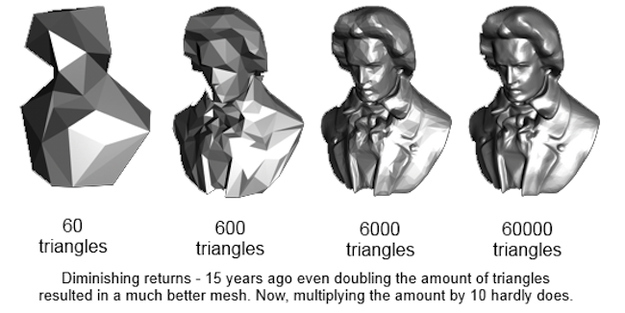Merry Christmas
Posted by Rampant Coyote on December 24, 2015

Merry Christmas everyone!
I found this old’ programmer pixel art from years ago, and thought I’d repost it. Just ‘cuz I knew you’d appreciate it. Or not.
I won’t be posting tomorrow (Christmas Day), so y’all have a safe and wonderful weekend. Good luck, and have fun!
Filed Under: General - Comments: Read the First Comment
Frayed Knights Discounted at the STEAM SALE
Posted by Rampant Coyote on December 23, 2015
 The Steam Winter Sale is ON. If you didn’t know. Like the fall sale, there are no special daily discounts – just overall discounts for the rest of the week. According to the current count, there are over 10,000 games discounted right now.
The Steam Winter Sale is ON. If you didn’t know. Like the fall sale, there are no special daily discounts – just overall discounts for the rest of the week. According to the current count, there are over 10,000 games discounted right now.
That is a lot.
One of those games is, of course, Frayed Knights: The Skull of S’makh-Daon. Now’s your chance to do some last-minute gift-giving and provide your friends with an awesome digital copy of this excellent game. Assuming, of course, you already have a copy yourself. If not… well, perfect chance!
If neither of these apply… well, it’s a dangerous time for your wallet, and I wish you the best. Maybe as a distraction you could, like, leave a review or something on that Frayed Knights page?
I’m much obliged. Good luck and have fun!
Frayed Knights: The Skull of S’makh-Daon on Steam
Filed Under: Deals, Frayed Knights - Comments: Comments are off for this article
Spoiler-Free: The Force Awakens
Posted by Rampant Coyote on December 22, 2015
 I was gonna come up with a catchy title here, but… screw it. Without giving away anything about the new Star Wars movie (at least nothing that wasn’t already revealed in the trailers and commercials), here’s my opinion (totally free and worth every penny):
I was gonna come up with a catchy title here, but… screw it. Without giving away anything about the new Star Wars movie (at least nothing that wasn’t already revealed in the trailers and commercials), here’s my opinion (totally free and worth every penny):
I’ve seen Star Wars: The Force Awakens twice now. If you are trying to keep yourself spoiler-free, it’s going to get harder and harder every day. If you are at all interested, see it sooner rather than later. The upshot is: I liked it a lot. It’s silly for me to point out that it has flaws… like, DUH. But I think it’s a worthy entry into the series, and it’s the best new Star Wars movie I’ve seen in 30 years… possibly since The Empire Strikes Back.
Okay, well, there are a million opinions out there. I thought I’d talk about mine, but without revealing spoilerish details about this movie.
When I saw the trailers, I was afraid to have hope. I remembered how wonderful the trailers for The Phantom Menace were, and how excited I was to see the long-awaited prequels. I was disappointed. We were all heartbroken. Unlike my wife, I do not hate the prequels… but they were made by someone who clearly didn’t understand why he had been successful with the original movies. They didn’t ruin the original trilogy for me (not in the way the Matrix sequels really detracted from the original).
Considering George Lucas’s lame explanation over his retcon of the “Han shot first” (and last) scene in the original movie, it’s clear he’s been pretty far out-of-step with his audience and fans for a while. It was time for a generation of film makers who were inspired by the original to see what they could do with it. But that’s hardly a guarantee of success.
Not only that, but the people who loved the original trilogy back in the late 70s and early 80s no longer exist. We changed. We grew up. I can go back and watch Star Wars (later dubbed “A New Hope“) and The Empire Strikes Back and maybe get a little bit in touch with the kid who originally saw the series wide-eyed and mind-blown in the theaters… a kid who wanted to grow up to become Luke Skywalker. The kid who listened to the soundtrack over and over again as he grew up. But I’m still a jaded grown-up who winces a little bit at the dialog, and willfully turns a blind eye towards the sometimes glaring faults. I love the movies, and celebrate the mastery that made them awesome, and leave it at that.
But if you were to somehow give me selective amnesia so that I completely forgot these films and showed them to me again, with my current age and experience, I’m not sure they’d rate as highly. Maybe The Empire Strikes Back wouldn’t remain my favorite SF movie of all time, and I’d say something like, “Well, it was good, but wasn’t in the same league as Serenity.”
All that is a way of saying that the original trilogy gains some significant benefits by being early and occupying the status of “classic.” In some ways, they are unassailable that way. It’s almost impossible for anything to top them. So a sequel has to fill some shoes that are bigger than they really should be.
All that being said… I think the new sequel pulls it off. It’s the Star Wars movie I’ve been waiting for since I was a kid.
Some people are complaining about how the new movie echoes the story of A New Hope. To me, this seems deliberate, and not a flaw. They wanted it to rhyme, and it does. It works. It’s the differences that are really exciting and intriguing. I’m interested in these new characters and seeing how they develop, as well as their relationships with the original characters. I want to know more about them and see what they do next. Contrast this with the prequels, where I seriously couldn’t give a crap about Anakin’s slide to the dark side…. the whole POINT of that trilogy. The characters felt like action figures from a toy line. They looked cool and posed.
From a purely technical standpoint – performances, story, special effects, etc. – this may be the best-made film of all seven. But it wasn’t the technical qualities that won audiences over originally.
Anyway, I feel good about the new stewardship over the movies. This new one felt like Star Wars to me. In a small way, I felt like a kid again, watching the individual films of what would eventually be the “original trilogy” for the first time. To me, that’s a big deal!
Filed Under: Movies - Comments: Comments are off for this article
Thoughts on the Steam Controller
Posted by Rampant Coyote on December 21, 2015
 In conjunction with the Steam Machines and so forth, Valve has launched a new game controller specifically designed to handle PC games. I picked one up, but I haven’t spent a whole lot of time with it. That’s actually an issue a lot of people have had with it. I’ve heard from some people who have used it a lot and love it, but it seems more people have been like me… tried it, shrugged, and chalked it up to a wasted $50, going back to their XBox controllers and the trusty keyboard + mouse.
In conjunction with the Steam Machines and so forth, Valve has launched a new game controller specifically designed to handle PC games. I picked one up, but I haven’t spent a whole lot of time with it. That’s actually an issue a lot of people have had with it. I’ve heard from some people who have used it a lot and love it, but it seems more people have been like me… tried it, shrugged, and chalked it up to a wasted $50, going back to their XBox controllers and the trusty keyboard + mouse.
At least I know I haven’t given it a fair shot yet, and I’m still trying to use it when and where I can. It’s something that takes getting used to, which means not playing a game particularly well for a while. One of the tricks, too, is that this isn’t really supposed to replace an existing USB game controller… it’s supposed to replace the keyboard and mouse. That’s a tall order.
For me, part of my problem is how I hold the controller. I tend to grip it more tightly and don’t leave my middle fingers on the shoulder buttons, which means I hit the paddle buttons on the bottom of the controller. It’s cool that they are there, but they are also kind of in the way. However, if I hold the controller more gently with two fingers resting on the shoulders, this shifts my grip and I hold it more easily.
I also keep hitting the right touchpad with my thumb, which moves the mouse around. That pad is just a natural place to rest my thumb. Maybe it’s just a learned thing from using other controllers over the last 20 years, but I have to get used to either keeping my thumb absolutely still in the dead-center of the touchpad, or resting it on the buttons.
Whatever the case, I suspect there may be some changes in a year or two with a Steam Controller 2.0, but I don’t feel the controller is fundamentally flawed. I’m not sure I’ll ever prefer using it over a keyboard and mouse, though. This controller is primarily for “couch gaming,” which was never really my thing. It may be a better way to play some PC games, however. And if I do make some forays into VR gaming, this might be just the thing.
Filed Under: Impressions - Comments: Comments are off for this article
Releases This Week
Posted by Rampant Coyote on December 18, 2015
 Final Fantasy VI – considered by many to be the best game of the entire series – released on PC this week. You can find it on Steam at this link, but I’m not sure where else. I’m not sure what I can say about it that hasn’t already been said by many more qualified than me. The original is a classic. It’s excellent. Like, really excellent, one of the best jRPGs of all time. It’s steampunk-ish. As far as the port to the PC, there are some complaints. The jump to higher resolution and a diversity of gaming platforms did not come without a cost.
Final Fantasy VI – considered by many to be the best game of the entire series – released on PC this week. You can find it on Steam at this link, but I’m not sure where else. I’m not sure what I can say about it that hasn’t already been said by many more qualified than me. The original is a classic. It’s excellent. Like, really excellent, one of the best jRPGs of all time. It’s steampunk-ish. As far as the port to the PC, there are some complaints. The jump to higher resolution and a diversity of gaming platforms did not come without a cost.
As for me? I’m okay with it. This probably says a lot about why I shouldn’t be trusted to make games, but while there are some things that don’t look quite right (the mix of styles, mainly, and the blurred look of the sprites), I’ve had fun playing. It’s going to take a LOT of playing to get back to where I last played many years ago. But there is also one great improvement: The two characters in the intro sequence are now named “Biggs” (not “Vicks”) and “Wedge,” after the characters in the original Star Wars movies.
And … speaking of which… there’s a movie out now. Something that I want to believe will be as awesome as I dream it could be. But I’ve been heartbroken before. I’ve got tickets for Monday. PLEASE avoid details / spoilers for at least a couple of weeks, okay? Thanks.
UPDATE: And one more! Underrail is now officially released. You can snag it on Steam or on GOG.COM. It’s a turn-based isometric-view post-apocalyptic indie RPG. I played an alpha demo of it a long time ago and thought it seemed like it had great potential. It looks even better now. Coolness!
Rock on and stay awesome!
Filed Under: Game Announcements, Movies - Comments: 2 Comments to Read
Design: Responsible Glitchiness
Posted by Rampant Coyote on December 17, 2015
Note: This is a heavily-edited (more like “influenced by”) version of an article that I wrote in 2006 for the old blog. If it rings at all familiar, that’s why.
My first Game Developer’s Conference was in 1995. This was when it was still called the “Computer Game Developer’s Conference” (CGDC), and it was the last year it tried to act “small.” There was rampant recruiting taking place (something which was downplayed in later years – probably because game development companies started getting reluctant to send their people there in fear of them getting snatched up by the competition). It was a great experience for me, new to the business of game development.
 One of the most educational sessions I ever sat in on was from that first conference. It was a roundtable on “Simulations and Simulators.” There were guys from Lucasarts, SSI, and several other companies in attendance, but it was still a small enough crowd (maybe 20 people?) that everyone who had something to say seemed to be able to say it. The moderator didn’t have much to do, because the discussion was lively.
One of the most educational sessions I ever sat in on was from that first conference. It was a roundtable on “Simulations and Simulators.” There were guys from Lucasarts, SSI, and several other companies in attendance, but it was still a small enough crowd (maybe 20 people?) that everyone who had something to say seemed to be able to say it. The moderator didn’t have much to do, because the discussion was lively.
It was fairly eye-opening for me as a newcomer to an industry that I’d only seen from the consumer side for fifteen years. It drove home a lot of issues that I perhaps understood in principle, but had never been exposed to concrete examples. Things like dealing with customers, marketing, the trade-offs you need to make in your design to maximize appeal (realizing that you are never going to please everyone all of the time), the issues relating to sequels in certain genres (a lesson that has apparenly been forgotten by most publishers these days), and so forth.
The problem that these guys were facing (I think it was a developer from SSI who had worked on the Panzer General series) is that they were really trying to satisfy two markets at once – the hardcore “wargamer” and the far more “normal” player. You have to be careful not to upset the hardcore group, we were warned, because they form your “opinion leaders.” They are the vocal minority. They go out on the Internet (back then it was mostly newslists and Bulletin Boards – the World Wide Web was still relatively new) and will spout off about how much a game sucks or rules. Less knowledgeable players won’t want to argue with the experts, and so sales will depend upon the opinions of this group that really only represents 20% (or less) of your players.
I don’t remember if it was the guy from SSI who threw out the term or not, but the partial solution was something he termed, “Responsible Glitchiness.” In the terms of hardcore simulations or wargames, it meant that you mindfully compromise realism or detailed options in favor of abstractions or simplifications that make the game more fun or easier to play.As he explained it, the hardcore players are always going to nitpick about something not being correct. The goal was to create something that would be appealing for “normal” players, and which the hardcore fans would gripe about, but admit that in spite of that, they had a blast playing it.
While it wasn’t brought up, an example in my mind might be weapon ranges. Now, in some cases (particularly sea combat), different weapon ranges might make such a huge difference in real life that they truly changed how the entire combat is portrayed. This was exactly how the horse-archers defeated the highly-trained Roman armies, or how modern warships with both a mobility and range advantage can literally run circles around their opponents with impunity. But in other cases, the range advantage of one weapon over another didn’t make a huge difference on the battlefield. For the purpose of abstraction in a simpler wargame, or in a first-person shooter, it may be “responsible glitchiness” to deliberately give the weapons exactly the same range for the purpose of making an entertaining and “fair” game.
 From the perspective of a hardcore “grognard” who has these kinds of things memorized, sure, it might be a “flaw.” In a more generalized approach… well, I’d hold up Firaxis’s XCom: Enemy Unknown as a stellar example. Maybe “glitchiness” isn’t the right term … but there were a lot of changes that had the old hard-core fans of the series concerned prior to its release. Quite a few, actually. But upon release, most of us left our apprehensions at the door and embraced the compromises, which were a lot more friendly to new audiences. But in the end, it was turn-based goodness that proved to the entire world what a bunch of us had been saying for years…. turn-based tactical doesn’t mean boring! (Yeah, Civilization had been proving that for years, but it had kind of been it’s own special case).
From the perspective of a hardcore “grognard” who has these kinds of things memorized, sure, it might be a “flaw.” In a more generalized approach… well, I’d hold up Firaxis’s XCom: Enemy Unknown as a stellar example. Maybe “glitchiness” isn’t the right term … but there were a lot of changes that had the old hard-core fans of the series concerned prior to its release. Quite a few, actually. But upon release, most of us left our apprehensions at the door and embraced the compromises, which were a lot more friendly to new audiences. But in the end, it was turn-based goodness that proved to the entire world what a bunch of us had been saying for years…. turn-based tactical doesn’t mean boring! (Yeah, Civilization had been proving that for years, but it had kind of been it’s own special case).
I think the principle could also be called “Responsible Streamlining” or “Responsible Fudging” or something else. Ultimately, it means making compromises. The “responsible” part is what I think a lot of modern developers – especially in AAA mainstream games – miss, as they rush to capture the the mass-market audience. You don’t want to leave your old, “hardcore” audience out in the cold, either. It’s not about just dumbing it down.
Filed Under: Design - Comments: 3 Comments to Read
The Dream Game
Posted by Rampant Coyote on December 16, 2015
 I used to have this recurring dream about an old arcade machine that I’d just discovered, or one that I’d somehow forgotten about. Why an arcade game? I think it’s rooted in that magical era of the arcade. Sort of in the same way we get the (manufactured?) urban legend of Polybius, that era kind of inspired that feeling of anything being possible with custom machines constantly changing inventory. You’d find a game in some arcade or gas station on the road once and possibly never see it again. That’s not even including the test venues for games in late development – sort of the “beta test” sites.
I used to have this recurring dream about an old arcade machine that I’d just discovered, or one that I’d somehow forgotten about. Why an arcade game? I think it’s rooted in that magical era of the arcade. Sort of in the same way we get the (manufactured?) urban legend of Polybius, that era kind of inspired that feeling of anything being possible with custom machines constantly changing inventory. You’d find a game in some arcade or gas station on the road once and possibly never see it again. That’s not even including the test venues for games in late development – sort of the “beta test” sites.
Now obviously, if a game was really good, it would generally become popular and be found everywhere. While there was always a chance of an overlooked gem, on the balance the seemingly rare, obscure games were not the best the industry had to offer. But that didn’t change this nagging feeling that somewhere out there was the ultimate game … maybe a bespoke classic. For me, this possibly stemmed from the fact that this did happen occasionally – maybe not in the epic, mind-blowing sense, but that was the whole point of going to the arcade: finding that really cool game that would devour your quarters or tokens voraciously because it was just so cool and fun. For me, those games bore names like Space Duel, Sinistar, Star Wars, Starfire, Shinobi (lots of “S” names there…), Defender Stargate, Joust, Tempest, Road Blasters, Black Tiger, and others. I didn’t remain enamored for long… eventually I’d discover the limits of the game, and go off in search of the next super-cool thing.
Back in the “Golden Age” of the arcades, these machines were significantly more capable than home systems of the equivalent era. The (potentially) custom hardware meant anything was theoretically possible.
So this recurring dream I used to have was about some lone arcade game that I’d discover in some pizza parlor or the back corner of an arcade somewhere. It’s absolutely amazing, with graphics way beyond the ability of machines of the era. There’s a whole world of exploration inside the thing (one of the key things to keep me interested in a game). And I wonder why nobody’s ever heard of this thing and I’m only now discovering it.
Well…. it’s been a while since the last time I had the dream. Maybe I’ll never have it again. The mystique is gone for me – possibly all the way down to the subconscious level – for six reasons:
#1 – The indie era has far surpassed the arcade era in terms of output. I think there are more indie games released on mobile and PC in a single week than an entire decade in the heyday of the arcade era. If I’m looking for diamonds in the rough or forgotten treasures, there’s better places to look, and they generally look and play nicer than half the arcade games of the era.
#2 – Modern game technology has blown away the impossible technological dreams of the past. The last time I had the dream, my PC was quite capable of imitating what I saw in the dream. Those limits have long been transcended, and we’re even potentially on the cusp of the VR revolution now, so there’s not a ton to be blown away by on that front.
#3 – The gaming hobby is glutted. It’s less a case of searching for buried treasure now as being buried by them. There are a plethora of great games to play now, really riveting stuff, and my problem is more having time to play them.
#4 – MAME has revealed a number of long-forgotten classics, including at least one that I remember seeing and never playing, but only imagining how it would be. And honestly? My imagination was far better. Anyway… hunting those old games is easy. There are still some forgotten gems in there, and I still discover new games, but my expectations are quite modest.
#5 – I’m a PC Gamer at heart. There’s not a whole lot out there designed to smack you down in 1-2 minutes to a quarter installments which really holds my interest. “Nintendo-hard” is not my thing. I like my games a bit more leisurely paced with a lot of depth.
#6 – I’m an indie now. I make my own games. I might consider this a bigger reason except for the fact that I’ve always made my own games, even back then. But I was always limited by technology. Although I still am, it’s not nearly the impediment it once was.
Like I said, it’s been a few years since I had the dream. Maybe my subconscious mind has finally gotten the message. Or I’ve successfully choked my inner 14-year-old to death. I dunno. Now I think my big dream would be to make a game that other people dream about. THAT would be awesome.
Filed Under: Geek Life - Comments: Comments are off for this article
Returning to the Underworld – Swords and Sorcery: Underworld Definitive Edition
Posted by Rampant Coyote on December 15, 2015
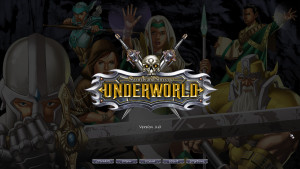 Swords and Sorcery: Underworld – the Definitive Edition has just been released today on Steam.
Swords and Sorcery: Underworld – the Definitive Edition has just been released today on Steam.
For those who remember the original – and the graphically updated “Gold” edition – this is a ground-up rewrite of the game using an engine planned for the sequel. If you played the earlier versions, this thing is… well, it is very familiar, but comparing them side-by-side is a night-and-day difference. The game system is changed, and is far more streamlined. The UI is vastly improved. The world, while still based on a grid, shows smooth 3D transitions as you move and turn. It supports high resolution full-screen. There’s new stuff across the board. So while it retains the storyline and overall feel of the original, it’s in many ways a completely new game. In effect, a full remake.
If you aren’t familiar with the original… well, consider this a brand new game.
What is it? I guess you could say that it started out as a fan-made love-letter to Might & Magic 1: The Secrets of the Inner Sanctum, and has since evolved into its own thing. Which is as it should be. After all, that was how Might & Magic started, too… a primarily solo effort to build on well-loved CRPGs in other series that went off in its own direction. The original release perhaps adhered too closely to the style of its inspiration, down to the clunky interface and programmer art, not to mention problems arising from the old version of Game Maker Studio. However, while a little clumsy at times, it also shared the benefits of its pedigree, capturing the flavor and fun that was just as captivating now as it was back in the late 1980s.
With the Definitive Edition, Swords and Sorcery: Underworld has fully come into its own. The Might & Magic spiritual ancestry leaves its mark on some of the level design, the class types, and the turn-based combat flow. The most noteworthy mechanic borrowed from the classic series is that player characters injured to zero health are first knocked unconscious (and can recover easily with standard heal spells) rather than killed. If they are subsequently damaged, then they are truly rendered dead … truly but temporarily in a world of major magical restorations. From there, the game marches off in its own direction, primarily in terms of graphics (bearing the heroic comic-book styles of the illustrator), sense of humor, and combat tactics.
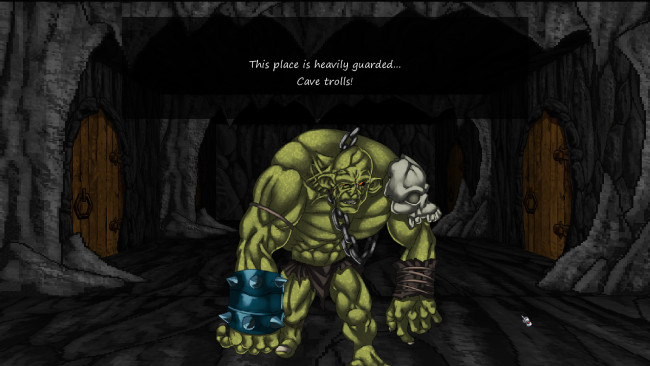
Combat is where the game system really shines. While it is abstracted in a similar style to other group-based first-person perspective turn-based RPGs, there are plenty of details and combat options to keep things interesting. Sometimes, due to luck or just being in over the party’s head, death just comes early and arbitrarily. But other times, the difference between a seemingly easy victory and a complete wipe-out (or a very costly victory requiring a return to the surface and maybe a visit to the temple for resurrections) is smart application of relative positioning, timing, and combat options.
Much to my joy, the rogue is a key class in any party build. The rogue’s ability to deal a devastating sneak attack, or to stun an opponent (even a boss) is absolutely invaluable in many fights. Archers, a little more optional, have some devastating multi-target attacks at higher levels which can be great at helping clear out lower-level minions or the leftovers from the sorcerer’s area-effect attacks.
The minions things is a big deal. With a combination of the knock-out mechanic and creatures with devastating attacks that can often deal more than a character’s hit point total in a single shot, large groups of enemies with multiple attacks are extra dangerous. With a single enemy dealing one attack per turn, no matter how damaging, you can keep reviving characters each turn to prevent anyone from dying. But with multiple attacks, enemy groups can knock out and kill a character in one sequence – a major setback even at higher levels.
Monsters are rarely limited to straightforward attacks and defenses, either. Even at the lowest levels, players will encounter enemies that summon others, explode for small amounts of damage to multiple party members, rangers that fade back outside of melee range to pelt the party with arrows, and so forth. Facing a new enemy is always makes me wonder when I saved last, because I may be unpleasantly surprised with some ability that I am not prepared to defend against.
The humor is less overt than, say, Frayed Knights. But its there. There are plenty of little in-jokes for gamers, particularly other role-playing games. Pictured below is my obvious favorite. Should I take offense that it’s like the most useless shield in the game? 😉

Some of the most interesting and amusing tidbits can be gathered via the mind-reading spell, which displays a creature’s stats and a little paragraph about their background. This can provide valuable insight, or sometimes just a bit of amusement.
I never finished playing the game in its earlier incarnations, an oversight I’ve been trying to remedy over the last week or so. However, this game is not small. While it may not be a 100+ hour behemoth like some games, but it’s going to take you dozens of hours. But as you can save anywhere (outside of combat, which usually doesn’t last long) and make some real progress in only a few minutes of play, it works well for a grown-up lifestyle.
If you are a fan of old-school CRPGs and would like to play something “like, but different” from the party-based classics of the Wizardry / Bard’s Tale / Ultima / Might & Magic style, I recommend checking it out.
Swords and Sorcery: Underworld – the Definitive Edition
Filed Under: Game Announcements, Impressions - Comments: 5 Comments to Read
Too Sick to Indie?
Posted by Rampant Coyote on December 14, 2015
I get this crazy idea that if I’m too sick to sleep, too sick to go to work, I’ll be able to take advantage of that sick time and get some indie dev time in (or at least write some blog posts).
It almost never works out that way. While I try to be paranoid and not infect my coworkers, in general if I’m too sick to drag my sorry butt into the office, I’m too sick to do anything but sleep and do some low-impact reading, video-watching, or gaming… all three of which activities may terminate in the middle with sleep.
This is why turn-based games rock. If you nod off in the middle from all the cold meds, when you wake up again staring at the same map or same dungeon corridor, you don’t need to worry about how long you were out. So long as you didn’t make any bogus moves while half-conscious, you just save the game and go to bed. Again. For the third time that day.
Sadly, that doesn’t make for productive development time. I managed to finish a white-boxed level and upgrade to Unity 5.3 before getting hit full-force with this cold. After that, I’ve only been able to scrape out a trickle of design work. You’d think with my weird medication-induced bizarro dreams I’d have tons of interesting creative work done for me, but… no. Not so much.
Fortunately, after a bit of crunch at the day job this week, I’m on break for a while for Christmas, and I hope it will be an awesome time with a lot of work done on FK2. I don’t think I’ll hit my goal of getting all of the levels completely navigable by the end of the month, but I won’t be too far off.
Filed Under: Game Development - Comments: 6 Comments to Read
Musings on Retrogaming
Posted by Rampant Coyote on December 11, 2015
 Sometimes I wonder if my weird retrogaming habit isn’t to appease my insatiable inner 13-year-old, who didn’t own a console system, and blew his allowance regularly at the local arcade. That kid had way more time than money, and not a lot of games (for a while).
Sometimes I wonder if my weird retrogaming habit isn’t to appease my insatiable inner 13-year-old, who didn’t own a console system, and blew his allowance regularly at the local arcade. That kid had way more time than money, and not a lot of games (for a while).
That was probably a good thing for me, in the long run. I wrote games because I wanted to play games, and most of what I could afford came a quarter-a-play. Or I’d play at a friend’s house. So I’d go home and dream of how to make games like these. Only better, of course. At the time, that was at least remotely achievable. These games were largely developed by teams of one or two people, over a period of just a few months. That was something a kid learning programming in his bedroom could aspire to. Nowadays, a AAA game is so far beyond the pale of what a newbie can even conceive of developing (and yet, they do…)
Then came college, when a lack-of-time kinda matched lack-of-money. By that point, I could afford the occasional game every month or two, and would play the crap out of it, because it was all I had. And I’d drool over the magazine ads and reviews for games I really wanted to play but couldn’t afford.
And now I’ve got very little time, but the prices on old games are ridiculously cheap… especially if you wait for sales. Hey, another PC game from the 90s that I was always interested in playing but couldn’t afford the $50 for… now for $7 (or $2 or $3 on sale)! Okay, maybe. And I’m supposed to play this game WHEN?
Ah, well. So I have a hoarding mentality. I could play games 50 hours a week for years at this rate and not get through them all.
The thing that’s funny is that for me, it’s not just playing the old favorites. Sure, going back and replaying the old Ultimas and Might & Magics is a blast, once I get over the clumsy interface. No problem there. But it’s also going back and playing the old titles for the first time, and seeing what I missed. Sometimes (most of the time), I find I didn’t miss much. Or whatever praise I remember hearing back in the day, it didn’t apply to me for some reason.
But then I encounter the occasional gem. Something overlooked when it was new. Something simple and fun. Sometimes those old games were only popular because they were technological novelties. But sometimes… well, they are just as fun now as then.
Most of the time, I feel like a collector these days. Not a collector of oddities or rare items. No, I just collect digital versions of games. And I think to myself, “I have this vast library of games… definitely one for any possible mood!” Except then I still can’t figure out what to play. It’s like picking a show to watch on Netflix. Staggered by possibilities.
I’m just glad that’s still an option. Thank you, emulator-makers!
Filed Under: Retro - Comments: 2 Comments to Read
Frayed Knights: How Do Players Do?
Posted by Rampant Coyote on December 9, 2015
I didn’t think about it when I put them in, but achievements are an interesting way to track how players progress through the game without having to resort to sneaky player-monitoring checks.
For Frayed Knights: The Skull of S’makh-Daon, only 3.5% of the players who start the game actually finish it. I understand that’s not totally out of the ballpark industry-wide, though it does feel like a loss and a failure on my part. By comparison, Final Fantasy VII‘s completion rate is 6.4% – nearly double that of FK, and it’s a longer game. Of course, it’s also a classic. So that’s something to shoot for in the future.

Although looking through the rest of the achievements, I don’t see any real clear marker for where people quit playing. It looks like a gradual falloff. Although — less than half of the players actually complete the first dungeon. Admittedly, there are a few games I’ve installed just to get a look-see at what the game was like, and then I quit, too. So…. I dunno.
Half the people who leveled up once (which happens before completing the first dungeon, the Temple of Pokmor Xang) went on to complete the Farmer Brown quest, which is actually an optional quest. Half of them completed the Tower of Almost Certain Death, obtaining the Skull of S’makh-Daon. And of those, about 1/3rd have completed the game.
I kind of expected a bigger drop-off between the “Rhyme and Reason” (Although that, too, is optional I believe… you can brute force your way through that one) point and the obtaining of the skull. Mainly because the tower can be pretty challenging, and I’ve heard anecdotally that people have gotten stymied there a few times. Apparently, that’s not as big a road block as I feared. After that, things go down pretty linearly – as I’d expect.
I guess what I’d like to see (for the sequel) is more people completing at least the first dungeon. I know that’s not a perfect measure of things – a lot of people are just checking things out and getting the lay of the land. But if everything else seems like a more consistent drop, I’d like to see it start with a higher level of completion rate.
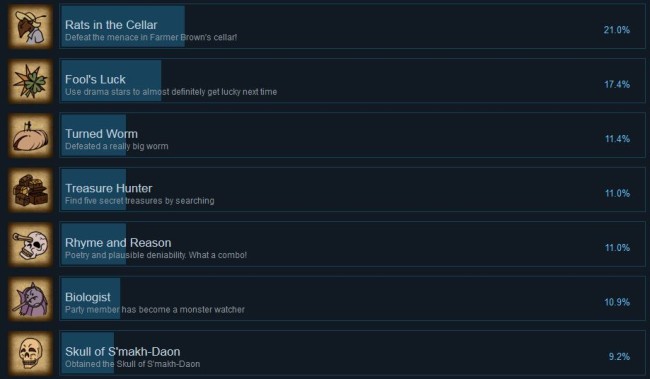
I guess since I’m one of the worst offenders for non-completion of games, I can do some self-analysis of my own gaming habits and see what leads me to quit a game before completion, and then compare them to FK1 and see what’s there that would set me off.
Filed Under: Frayed Knights - Comments: 8 Comments to Read
Making Weapons in Fantasy Worlds More Interesting by Banning Them
Posted by Rampant Coyote on December 8, 2015
 The crossbow was once banned for use (“against Christians”) by Pope Innocent III. It was the “ultimate weapon.” The prevailing belief is that this was done because it took minimal training to use and could penetrate a knight’s armor at range. Since knights were the “main battle tanks” of the era, the idea that these expensive (and politically connected) warriors could be wiped out easily by a bunch of peasants fresh off the farm was pretty alarming to the noble classes from whose ranks they came. The crossbow was an equalizer on the battlefield, which is great for the people on the disadvantaged side of the equation, but not so much on the side that owned the land, wealth, and who made the rules. With the pope’s help to give it the force of not just law but a sin, they tried to stem the tide of technology. It didn’t “stick” for long, though.
The crossbow was once banned for use (“against Christians”) by Pope Innocent III. It was the “ultimate weapon.” The prevailing belief is that this was done because it took minimal training to use and could penetrate a knight’s armor at range. Since knights were the “main battle tanks” of the era, the idea that these expensive (and politically connected) warriors could be wiped out easily by a bunch of peasants fresh off the farm was pretty alarming to the noble classes from whose ranks they came. The crossbow was an equalizer on the battlefield, which is great for the people on the disadvantaged side of the equation, but not so much on the side that owned the land, wealth, and who made the rules. With the pope’s help to give it the force of not just law but a sin, they tried to stem the tide of technology. It didn’t “stick” for long, though.
In Japan, starting in the late 16th century, “Sword Hunts” were called to disarm the commoners. The nobility could still carry weapons, which gave them a natural advantage. It limited the potential for peasant uprisings, and equally important slowed the ability for rivals to raise up armies and do to the new rulers what the new rulers had done to the previous ones. The weapons restrictions stirred up a great deal of discontent, increased class stratification, and empowered criminal ronin. But it also led to the development of some pretty awesome martial arts weapons techniques using farming implements turned into deadly weapons.
Previously, Frederick Barbarossa and other rulers in Britain and Europe had occasionally banned advanced weapons (like swords) from the peasantry. This sounds like a bit of an overkill on the class stratification thing again… it’s not like peasants could often come close to affording a sword, or even a nice spear. Maybe this was the Holy Roman Emperor’s attempt to hog up the battlefield loot for himself and his boys? (I have no idea… taking a dead knight’s sword might have been uber-taboo …)
 George Silver wrote a lengthy objection to the use of the rapier in his work, “Paradoxes of Defense” in the late 1500s. In this case, it wasn’t so much to protect the higher classes from the low-born so much as to protect his countrymen from what he believed was a dangerous weapon and fighting style that had no practical use on the battlefield or a real fight. His work didn’t have the force of law, of course, and it didn’t seem to change many opinions, but it stands as a fascinating historical look at the schools of thought in European martial arts. Granted, some rapiers were getting kind of ridiculous among the upper class at the time. They were a status symbol, sometimes absurdly long, like a really stupid spear. Cue jokes about compensation.
George Silver wrote a lengthy objection to the use of the rapier in his work, “Paradoxes of Defense” in the late 1500s. In this case, it wasn’t so much to protect the higher classes from the low-born so much as to protect his countrymen from what he believed was a dangerous weapon and fighting style that had no practical use on the battlefield or a real fight. His work didn’t have the force of law, of course, and it didn’t seem to change many opinions, but it stands as a fascinating historical look at the schools of thought in European martial arts. Granted, some rapiers were getting kind of ridiculous among the upper class at the time. They were a status symbol, sometimes absurdly long, like a really stupid spear. Cue jokes about compensation.
I don’t want to talk about modern weapon bans or restrictions, because that gets pretty politically charged. So I’ll stick with the medieval and renaissance eras. Taken from these examples, the real purpose behind the historical restrictions was to protect the ruling class (in these cultures, the warrior class) and and maintain the political status quo. As technology advanced and put more powerful weapons within the grasp of the non-warrior-class, undermining the advantages of expensive armor, weaponry, and lifelong training, said ruling class would often outlaw the weaponry. In the long run, technology is an equalizer, and those in a position of power are naturally inclined to fight against that. (It should be noted that in the short term, technology tends to have the opposite effect, as the advantages are unaffordable to all but the wealthy.)
So… pulling all that into a fantasy world representing approximately this same era… let’s talk about MAGIC WEAPONS!
If magic weapons are extremely rare… precious artifacts of dubious power… then nothing really changes. Most fantasy novels are like this. The occasional Sting or Glamdring isn’t going to change things too much.
Likewise, when magic is something only practiced by a rare few, especially with some kind of centralized authority that can be controlled or negotiated with – or at least kept tabs on – this might not change things too much.
But where magic items start becoming common – like many role-playing games or settings like The Forgotten Realms – magic ends up taking on a role similar to technology in the real world, and one could expect those in power would start breaking out the ol’ ban-hammer. When some farm-boy (like many origin stories) picks up a magical sword that, with minimal training, makes him the equal of a knight, people are going to have problems with that. Particularly the knights or the parents of the knights who spent a fortune on equipment and training and are part of a an established social order.
So magic weapons and armor get outlawed. Maybe this is part of a more sweeping practice of outlawing weapons and armor in general, although in fantasy worlds with predatory outlaws and monsters looming on the outskirts of every village, this might not be practical. But again, those in power don’t want an army of former farm-boys with magical weapons to rise up against them. They’d probably rather the knights under their (relative) control had the monopoly on magical enhancements.
Now, as a player in a game, this sounds super-boring. But it’s actually the opposite. It adds drama to a setting. It’s not that the player’s can’t have cool magical gear… it’s that they can’t have them legally. When you create crimes, you create criminal activity. Weapons smuggling. Black-market armor dealers. Even the noble-hearted but low-born paladin might have to fight between obedience to the law of the land, which may or may not be for the “greater good,” and their higher purpose which demands they face evil with weapons imbued with greater than mere mortal craftsmanship. Spells that hide or disguise the magical aura (dweomer, to use a term Gary Gygax was fond of, aka dwimmer) might be extremely valuable. A spell like Magic Aura – which creates an artificial magical aura – could be very powerful when used against a rival at the right time.
In short, there’s tension and a slew of cool storytelling potential there.
Now, Silver’s case is another interesting one – an effort to preserve what he felt was a “best practice” for fighting against a fighting style that was a new social trend but of limited value in actual warfare. This opens up a whole ‘nother can of words worth thinking about as either a writer, designer, or game-master.
Weapons can be “trendy,” and it may not have anything to do with their actual effectiveness. This can be on a military scale. Many scholars believe the adoption of firearms by the military was premature – it wasn’t until around the 1700s or 1800s that they actually became superior to a plain ol’ bow or crossbow. Whoever is in charge decides that this weapon is the “thing.” But it can also be on a social level. The popularity of the fencing masters of France and Italy caused the swell of interest in the rapier. A hero like Xena or Robin Hood can increase general interest in their weapons of choice.
This could be a way to give a culture or a community some distinctiveness. Maybe it’s a trendy thing to use a flamberge, an expensive status symbol in a certain city. Maybe a mace of a particular design is considered the holy weapon of a particular deity, and people wield one as an outward symbol of devotion even if they aren’t particularly pious. Maybe after a local hero defeated Goliath with a sling, the sling became a weapon of choice within the community.
And maybe there’s a rivalry between fans of different kinds of weapons. Why not? Or between scale mail versus chain mail? Just think about how modern flame-wars can erupt between fans of Star Wars versus Star Trek, and transpose that to late 16th century arguments over weaponry featuring George Silver, and enjoy! Your readers or players will hopefully find it a lot more interesting!
Filed Under: General - Comments: 4 Comments to Read
RPG Design: Realistic Dungeons?
Posted by Rampant Coyote on December 7, 2015
 A couple of weeks ago, we had a discussion in the comments section about using real-life castles and dungeons in RPGs. I thought I’d elaborate on my thoughts in a post.
A couple of weeks ago, we had a discussion in the comments section about using real-life castles and dungeons in RPGs. I thought I’d elaborate on my thoughts in a post.
Many years ago, with access to a university library, I researched tons of actual castles – mainly European – searching for maps and floor plans. I still have that folder laying around somewhere. Combined with an old and well-used purchase, Palladium’s The Compendium of Weapons, Armour, and Castles (one of my favorite game guidebooks ever), I not only had a whole bunch of ready-to-use maps for our dice-and-paper games, but I had a much better understanding of many of the whys and hows of castle design.
But there is a problem. Lots of problems. Realistically, these structures were built to prevent enemies from doing exactly what the players are doing. Assuming an organized, intelligent defense (which we almost never do in RPGs), the party would be dead before it breached the first wall, let alone penetrated the central tower / keep / donjon and could begin the room-to-room clearing so common in these games. And if they did get that far, things were even nastier.
See, everything in a castle was designed (at least originally) so that a tiny force of defenders could hold off an army of attackers. That was the point. The shields and weapons hanging on the walls weren’t for decorations. The rounded design was less vulnerable than square corners to siege weapons like trebuchets and cannons. The tiny, twisty halls are supposed to limit attackers to moving through in single-file. The entryway into the front was often designed to run parallel to one wall of the castle so that it exposed attackers to attack along the entire route. Even the spiral stairways were designed to impede the ability for a right-handed attacker to swing a weapon, while giving a defender much more freedom. And of course, there were things like murder holes, arrow slits, and so forth to maximize defender cover while exposing the invader to constant attack.
While this could be a really cool tower defense game idea, or a decent strategy game (and it has been), it’s a lot more problematic for role-playing games. Likewise, the best strategy against something like this would be to settle in for a long siege, if possible, and starve the defenders out. Not exactly fun from an RPG perspective (“The second month passes. Do you do anything differently?”).
 We were (still are? It’s for Frayed Knights 3) using a floor-plan for Bran Castle as a baseline for one level. We ran into some problems based on real-world architecture, even as we took a lot of liberties with the floor plan. Halls and stairs and doorways are designed to be tight and confining in the real world, and are almost impossible to navigate on a 3D screen. Perhaps in a VR environment with a setup that can track your fine body movements as you duck, twist, and lean to go through the environment, that would work out okay (although without tactile feedback, maybe not), but in the simplified 3D environment and controls of modern video games, it just doesn’t work. Ditto for caves. Those can be hard to navigate in real life, and even harder for the player – let alone AI – to believably walk through in a game.
We were (still are? It’s for Frayed Knights 3) using a floor-plan for Bran Castle as a baseline for one level. We ran into some problems based on real-world architecture, even as we took a lot of liberties with the floor plan. Halls and stairs and doorways are designed to be tight and confining in the real world, and are almost impossible to navigate on a 3D screen. Perhaps in a VR environment with a setup that can track your fine body movements as you duck, twist, and lean to go through the environment, that would work out okay (although without tactile feedback, maybe not), but in the simplified 3D environment and controls of modern video games, it just doesn’t work. Ditto for caves. Those can be hard to navigate in real life, and even harder for the player – let alone AI – to believably walk through in a game.
The best we can do is borrow some elements from real life to give it some of that authentic flavor, and then go from there. The trick, really, is to borrow the cool parts and challenges from reality, and turn it into something fun and dramatic for the players. That’s why many of the classic fantasy role-playing adventures actually happen in ruins or abandoned castles, with many of the defenses falling into ruin or enemies unable to take full advantage of what is left. Dealing with kobolds pouring boiling oil through murder holes once or twice might be an interesting challenge for adventurers; being subjected to a constant barrage of harassing attacks gets old.
Reality isn’t always fun… that’s why we have our escapist fantasies. We don’t really want “realism” – we want drama and action and story that feels authentic. Borrowing liberally from real life gives the games a better feeling of verisimilitude and helping it ring true to the players. And it can provide some cool ideas.
Filed Under: Design - Comments: 12 Comments to Read
Utah Winter Faire
Posted by Rampant Coyote on December 4, 2015
I’m going to be at the Utah Winter Faire today and tomorrow, signing books ‘n stuff. It’s a really fun event… lots of geek shopping for the season, entertainment, food, and costumes.
If you happen to be around Farmington, Utah, you can catch me here! Unless I see you coming and can run faster than you. Doubtful, in these big steampunky boots…
Take care and have fun!
Filed Under: Events - Comments: 3 Comments to Read
Breaking the RPG Mold – “The Fanatic and His RPG”
Posted by Rampant Coyote on December 3, 2015
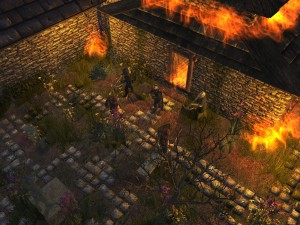 This is one of the best reviews / commentaries about a game I’ve read in a long while. The game in question is “Age of Decadence,” the long-awaited Magnum Opus from Iron Tower Studio. I haven’t played the full version yet, though it’s high on my list. I played a previous build and was impressed. I’ve definitely gotta hand it to Vince Weller and his team. They’ve pursued this thing with dedication to a seemingly impossible ideal, and from what I can tell, they pulled it off.
This is one of the best reviews / commentaries about a game I’ve read in a long while. The game in question is “Age of Decadence,” the long-awaited Magnum Opus from Iron Tower Studio. I haven’t played the full version yet, though it’s high on my list. I played a previous build and was impressed. I’ve definitely gotta hand it to Vince Weller and his team. They’ve pursued this thing with dedication to a seemingly impossible ideal, and from what I can tell, they pulled it off.
But your garden variety computer role-playing game, it isn’t.
Gamasutra: The Fanatic and His RPG
An excerpt. Well, two, with a bit cut out between them….
“The game is universally described as punishingly difficult, but that is not quite so. The game is impossible—at least at first pass—if one comes to it with the expectations built up by fifteen years of power-fantasy RPGs. You can’t have things in Decadence just because you want them; every fight is a struggle against enemies who are determined to live and who have lived so far by killing…”
And a paragraph and a half later…
“At the same time, if you meet The Age of Decadence on its own terms—focused in your desire, diligent in your work—anything is possible. For example, take a narrowly focused “talker” character. Bioware infamously promised that in Dragon Age: Origins, you would be able to “enslave nations with necromancy.” (Notably, the game did not include necromancy at all.) Decadence one-ups even this sales pitch: here, you can topple all the heads of state in the world through the gift of gab. My powers of speech brought me to vertiginous arrogance. But at the end of the day, you can’t sweet-talk a broken down machine; you can’t charm the secrets out of an ancient book of lore; you can’t gull a swarm of giant scorpions.”
Filed Under: Indie Evangelism - Comments: 3 Comments to Read
Computer Tech Eases Off the Gas
Posted by Rampant Coyote on December 2, 2015
Heh – after yesterday’s awesome comparison of the 1957 Elliott 405 to last week’s release of the Raspberry Pi Zero, here comes news that the phenomenal growth in computer power over the decades may finally be hitting the limits of both physics and economics. Moore’s Law isn’t coming to an end, exactly, just downshifting a little bit with slower growth:
Bloomberg Business: Chips Aren’t Getting Much Smaller, and That Stinks for Intel
This is probably not bad news if you are the type who hates having to constantly upgrade their phone and/or computer because of obsolescence. Now electronics will take ~66% longer to become obsolete!
I think part of what might be driving it (besides, you know, science and physical limits to sizes, until we get quantum computing figured out) is simply that we’ve hit the law of diminishing returns in many areas. Back in the 80s and 90s, the difference in performance between two-year-old tech and modern tech was extreme. This made game development on PCs particularly challenging, because it was a fast-moving target. If you were too optimistic, your game was unplayable on any but the most bleeding-edge machines when you released. If you were too conservative, your game looked dated and boring the day it released. The difference in horsepower was that noticeable.
Now, not so much… And if consumers don’t notice the difference, demand will drop. For example, if you double the polygon count of a model, it’s hardly noticeable nowadays, as this graphic that has been circulating for several years illustrates:
I still like having what was once considered astronomical amounts of RAM and drive space becoming available for cheapski, pennies-on-the-gigabyte. I’ve lived with Moore’s Law (or better) being kind of a guidepost for how technology will advance for my entire career, and so any suggestion that it’s slowing down does give me some misgivings.
But realistically, I don’t see this being a huge impact in my life. I’m not one of the guys pushing the bleeding edge who will have to wait longer for tech to catch up to my vision.
Filed Under: General - Comments: 4 Comments to Read
